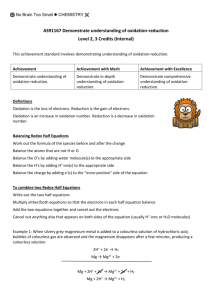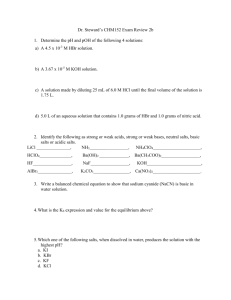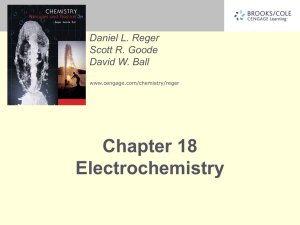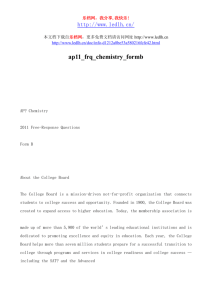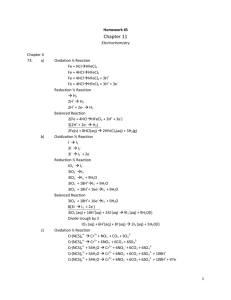Information: Half Reactions
advertisement
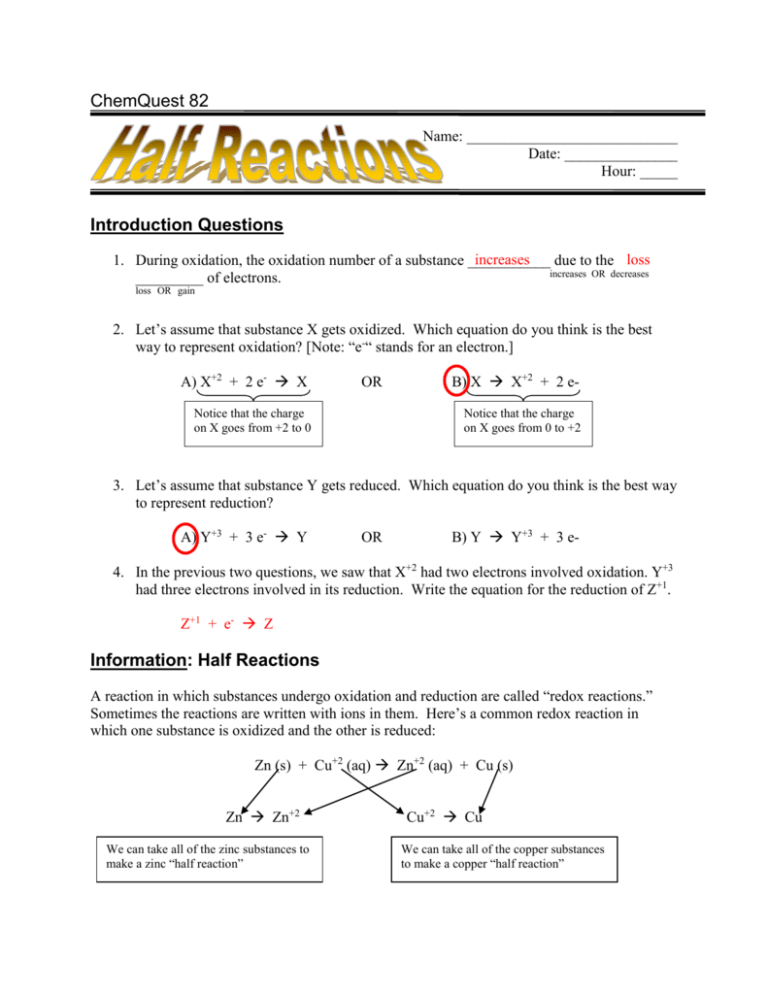
ChemQuest 82 Name: ____________________________ Date: _______________ Hour: _____ Introduction Questions increases 1. During oxidation, the oxidation number of a substance ___________ due to the loss increases OR decreases _________ of electrons. loss OR gain 2. Let’s assume that substance X gets oxidized. Which equation do you think is the best way to represent oxidation? [Note: “e-“ stands for an electron.] A) X+2 + 2 e- X OR Notice that the charge on X goes from +2 to 0 B) X X+2 + 2 eNotice that the charge on X goes from 0 to +2 3. Let’s assume that substance Y gets reduced. Which equation do you think is the best way to represent reduction? A) Y+3 + 3 e- Y OR B) Y Y+3 + 3 e- 4. In the previous two questions, we saw that X+2 had two electrons involved oxidation. Y+3 had three electrons involved in its reduction. Write the equation for the reduction of Z+1. Z+1 + e- Z Information: Half Reactions A reaction in which substances undergo oxidation and reduction are called “redox reactions.” Sometimes the reactions are written with ions in them. Here’s a common redox reaction in which one substance is oxidized and the other is reduced: Zn (s) + Cu+2 (aq) Zn+2 (aq) + Cu (s) Zn Zn+2 We can take all of the zinc substances to make a zinc “half reaction” Cu+2 Cu We can take all of the copper substances to make a copper “half reaction” Critical Thinking Questions 5. The above half reactions need some electrons added to one of the sides so that they will look similar to questions 2 and 3. a) Label each half reaction as “oxidation” or “reduction.” Also, follow the pattern of questions 2 and 3 and add electrons to the correct side of each equation. oxidation ___________________: Zn (s) reduction ___________________: Cu+2 (aq) Zn+2 (aq) Cu (s) b) How many electrons did you add? Why did you choose this number? 2 6. Split the following reaction into two half reactions—an oxidation and a reduction half reaction. Write each half reaction with the proper number of electrons in each. a) Ag+ + Ni Ag + Ni+2 Oxidation ½ reaction: Ni Ni+2 + 2 e- Reduction ½ reaction: Ag+ + e- Ag b) I2 + Sn 2 I- + Sn+2 Oxidation ½ reaction: Sn Sn+2 + 2e- Reduction ½ reaction (done for you ): I2 + 2e- 2 IQuestion: Why are there 2 electrons instead of one? Each iodine gains an electron. c) Mn+2 + 2 Br- Mn + Br2 Oxidation ½ reaction: 2 Br- Br2 + 2 eReduction ½ reaction: Mn+2 + 2e- Mn 7. True or False: A substance is reduced by gaining electrons. TRUE Information: Reduction Potential Potential: having the likelihood of occurring. In electrochemistry there is a term, “reduction potential.” The reduction potential is a measure of how likely a substance is to be reduced. Reduction potential is measured in volts (V) and is given the symbol Eo. The more positive the reduction potential (Eo), the more likely a substance is to be reduced. Table 1: Some common reduction potential values: Reduction Half Reaction F2 + 2e 2F Co3+ + e- Co2+ Cl2 + 2e- 2ClO2 + 4H+ + 4e- 2H2O Br2 + 2e- 2BrHg2+ + 2e- Hg Ag+ + e- Ag Fe3+ + e- Fe2+ I2 + 2e- 2ICu2+ + 2e- Cu Cu2+ + e- Cu+ Sn4+ + 2e- Sn2+ 2H+ + 2e- H2 Fe3+ + 3e- Fe Pb2+ + 2e- Pb Sn2+ + 2e- Sn Ni2+ + 2e- Ni Co2+ + 2e- Co Cr3+ + e- Cr2+ Cd2+ + 2e- Cd Fe2+ + 2e- Fe Cr3+ + 3e- Cr Zn2+ + 2e- Zn 2H2O + 2e- H2(g) + 2OHV2+ + 2e- V Mn2+ + 2e- Mn Al3+ + 3e- Al Mg2+ + 2e- Mg - - Eo (in Volts) +2.87 +1.80 +1.36 +1.23 +1.07 +0.85 +0.80 +0.77 +0.54 +0.34 +0.15 +0.15 0.00 -0.04 -0.13 -0.14 -0.25 -0.29 -0.40 -0.40 -0.41 -0.74 -0.76 -0.83 -1.18 -1.18 -1.66 -2.37 Critical Thinking Questions 8. True or False: Pb2+ is more likely to gain electrons than Br2. FALSE 9. Use the above table to rank the following in order from most likely to least likely to be reduced: Ni2+, Cl2, Mn2+, Sn4+ Cl2, Sn+4, Ni+2, Mn+2 10. If oxidation is the opposite of reduction, which do you think is most likely to be oxidized: Cd2+ or Fe3+? Cd+2 11. Which of the following is most likely to be the best reducing agent—Pb2+ or F2? Pb+2 because it is most likely to be oxidized 12. The Eo value for Cl2 + 2e- 2Cl- is +1.36 V. If we reverse the reaction so that Cl- is being oxidized, the reaction looks like this: 2Cl- Cl2 + 2e- oxidation potential = ??? To find the oxidation potential for this new oxidation reaction, what should we do to the +1.36 value? A) Change the sign to make it negative B) divide it by two C) square it Hint: What makes the most sense based on what we did for Hess’s Law?
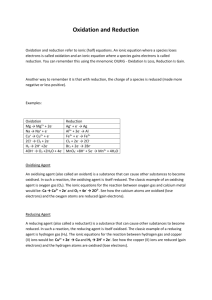


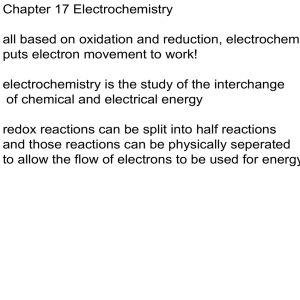
![Redox_equations[1].](http://s2.studylib.net/store/data/005611618_1-b55ee2e3a52621e48ab97cc179174553-300x300.png)

